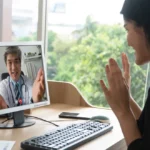Wearable Devices & Their Role in Remote Patient Monitoring

FDA approved Wearable devices are transforming the healthcare industry by allowing for the continuous tracking of vital information, detection of potential issues at an early stage, and improved management of on-going health issues within the framework of Remote Patient Monitoring (RPM). These devices range from smart watches to medical-grade devices that facilitate the early detection of medical issues, reduce the need for in-person consultations, and improve tailored treatment options.
In this technologically advanced world, a wristwatch tells a lot more than time. It can track our steps, measure our heart rate, count our oxygen levels, and our sleep quality among many other health tracking features.
Imagine just putting on a wearable device on your wrist and getting your vitals tracked in just seconds. This powerful technology is transforming the healthcare sector and acting as a boon in Remote Patient Monitoring (RPM) . By getting real-time insights into a patient’s health data, a physician or a qualified healthcare provider can enhance patient outcomes with timely diagnosis, tailored treatment plans, resulting in a better quality of life.
In this blog post, we’ll discuss in detail about the wearable devices and the role they are playing in remote patient monitoring.
Table of Contents
ToggleEvolution & Mechanism Of Wearable Devices
Though wearable technology has been present for a while now, it’s adapting every day with new features and sensors being introduced. The modern-day wearable devices span from fitness trackers and smart watches to smart glasses and ECG monitors that offer a myriad of health tracking features.
Compared to Bluetooth devices, a broader range of cellular and Wi-fi enabled wearables are readily available. Most of them are designed and developed on the latest technology, ranging from IoT, cloud computing, artificial intelligence (AI), and machine learning. The vitals or health data collected by these devices is analyzed and interpreted by healthcare professionals in a remote setting to provide actionable insights into a patient’s health and well-being.
What makes these devices collect, record, and interpret health data are sensors that are a sort of miniature devices designed to monitor a wide range of physiological parameters, such as heart rate, blood pressure, body temperature, body glucose, and oxygen levels.
Advanced algorithms and artificial intelligence features are used for predictive analytics that help understand data, discover health patterns, and predict possible risks in a patient with one or multiple chronic conditions. A healthcare provider can then act in a proactive manner to keep track of a patient’s real-time health reports and gain critical insights into their existing condition.
Role Of Wearable Devices In RPM
Ever since being introduced, wearables have made a breakthrough in the healthcare industry. They are not just fitness trackers anymore and are helping providers in making timely interventions by allowing continuous monitoring via a remote patient monitoring platform. Sensors embedded in wearable devices measure physiological factors. Some of its benefits include:
- Early detection of symptoms: Wearable devices can aid in the early detection of abnormal heart rate, fast pulse rate, irregular breathing patterns, oxygen rate, and a lot more. This early detection may allow for timely medical intervention and diagnosis, thereby preventing medical emergencies.
- 24/7 consistent monitoring: Wearable devices provide healthcare professionals with real-time data about a patient’s health, along with round the clock monitoring with a focus on improving their overall health and wellness.
- Improved patient engagement: Since these devices are easy to use and wear, they encourage active patient participation in controlling their ill-health conditions. They do so by closely monitoring heart rate, physical activity, and other health indicators to ensure overall better health outcomes.
- Data collection for research: Large scale data acquired from wearable devices can provide useful insights into population health and support research initiatives, especially for healthcare providers managing dispersed populations and when they are actively involved in implementing a successful remote patient monitoring program.
- Empowers providers and healthcare industry: Wearable devices offer providers a better control over their patient’s health by helping them understand how lifestyle changes or the actions like exercising, is positively improving their health. Wearables provide physicians with access to more real-time data that they can utilize to provide patients with guidance or treatment that prevent disease progression. For providers seeking compliant, high-quality tools for implementation, understanding the range of FDA-approved RPM devices is essential for ensuring clinical effectiveness and reimbursement alignment.
Key takeaways
- Continuous Monitoring: Real-time tracking of vital signs such as heart rate, blood pressure, and oxygen saturation level.
- Early Intervention: Issues and detects changes in health status prior to escalation to emergencies.
- Patient Engagement: Motivates self-care and proactive management of personal health.
- RPM Integration: Integrates effortlessly with the respective monitoring systems for health care providers to review.
- Better Outcomes: Reduces the rate of readmission and the total cost of care.
Frequently Asked Questions (FAQs)
FDA approved wearable devices are health tracking tools, such as continuous glucose monitors, ECG patches, and smart watches, that meet the U.S. Food and Drug Administration’s safety and accuracy standards for medical use in Remote Patient Monitoring (RPM).
RPM programs support patients by improving health insights and providing remote monitoring, which lessens the clinic visit burden and improves communications with the care teams.
Absolutely not. Leading RPM systems primarily encrypt patient data, preserving confidentiality and adhering to HIPAA’s stringent privacy and data safeguards.
Yes, these devices assist in the continuous monitoring of health metrics, which is essential in managing chronic diseases such as diabetes, heart diseases, and hypertension.
Clinicians look at the data from wearable devices, both current and past trends, to help them make decisions,
Reach Your Health Goals With HealthArc’s Wearbles & Cellular Devices
Wearable devices have greatly transformed virtual healthcare by playing a crucial role in remote patient monitoring. These devices make virtual care more efficient, more accessible, and patient-friendly through real-time, continuous health data reporting.
HealthArc’s cellular devices are driving the success of RPM programs by offering ease of use, reliability, and flexibility in connectivity options. Apart from offering cellular devices, HealthArc has an open device ecosystem where it not only integrates with other bluetooth devices but also with wearable technology like fitness trackers, apple health, etc. Our devices can be used outside of the US and work in over 150+countries, making them a more flexible option for patients who travel internationally.
Along with cellular devices, our RPM software is focused on encouraging a healthy lifestyle while reducing the cost burden on healthcare providers. Our advanced care management platform helps practices in connecting to their patients in a remote setting, without compromising the healthcare delivery.
With our RPM software, optimize reimbursement and minimize documentation for increased clinical efficiency. Being HIPAA-compliant, we promise unmatched data security and privacy, along with adherence to reimbursement and billing policies.
Wearables are just one piece of a much larger innovation in digital healthcare. Explore the full scope of RPM in our Complete Guide to Remote Patient Monitoring to understand how devices, care protocols, billing, and chronic care models work together to drive better outcomes.
Schedule a demo to learn more about how our cellular devices and wearables can boost your RPM program or call us today at +201 885 5571 to set up a consultation with our experts.
Most Recent Blogs
Categories
Related Blog
- November 26, 2025 | Read Time: 14 mins
Return on Investment (ROI) of Remote Patient Monitoring (RPM): A Complete Guide for ACOs and Healthcare Organizations
The U.S. healthcare system continues its transition from fee-for-service models to value-based...
Learn More- November 24, 2025 | Read Time: 15 mins
Common RPM Pricing Models for Providers: A Profitability-Focused Guide
Remote Patient Monitoring (RPM) has rapidly emerged as one of the leading...
Learn More- October 23, 2025 | Read Time: 12 mins
How RPM Devices Improve Hypertension and Diabetes Outcomes in Medicare Populations
Remote patient monitoring (RPM) is transforming chronic care for Medicare beneficiaries. CMS...
Learn More


